Oscillation and Harmonic Motion
Consider the following physical phenomena:
- When you drop a rock into a still pond, the rock makes a big splash, which
causes ripples to spread out to the edges of the pond.
- When you pluck a guitar string, the string vibrates back and forth.
- When you rock a small boat, it wobbles to and fro in the water before coming to
rest again.
- When you stretch out a spring and release it, the spring goes back and forth
between being compressed and being stretched out.
There are just a few examples of the widespread phenomenon of oscillation.
Oscillation is the natural world’s way of returning a system to its
equilibrium position, the stable position of the system where the net force
acting on it is zero. If you throw a system off-balance, it doesn’t simply
return to the way it was; it oscillates back and forth about the equilibrium
position.
A system oscillates as a way of giving off energy. A system that is thrown
off-kilter has more energy than a system in its equilibrium position. To take
the simple example of a spring, a stretched-out spring will start to move as
soon as you let go of it: that motion is evidence of kinetic energy that the
spring lacks in its equilibrium position. Because of the law of conservation of
energy, a stretched-out spring cannot simply return to its equilibrium position;
it must release some energy in order to do so. Usually, this energy is released
as thermal energy caused by friction, but there are plenty of interesting
exceptions. For instance, a plucked guitar string releases sound energy: the
music we hear is the result of the string returning to its equilibrium position.
The movement of an oscillating body is called harmonic motion. If you were to
graph the position, velocity, or acceleration of an oscillating body against
time, the result would be a sinusoidal wave; that is, some variation of a
y =
a sin bx or a
y =
a cos bx graph. This
generalized form of harmonic motion applies not only to springs and guitar
strings, but to anything that moves in a cycle. Imagine placing a pebble
on the edge of a turntable, and watching the turntable rotate while looking at
it from the side. You will see the pebble moving back and forth in one
dimension. The pebble will appear to oscillate just like a spring: it will
appear to move fastest at the middle of its trajectory and slow to a halt and
reverse direction as it reaches the edge of its trajectory.
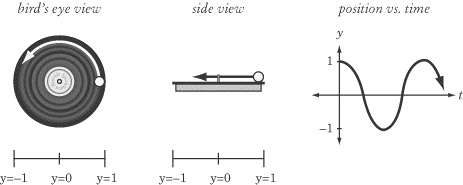
This example serves two purposes. First, it shows you that the oscillation of
springs is just one of a wide range of phenomena exhibiting harmonic motion.
Anything that moves in a cyclic pattern exhibits harmonic motion. This includes
the light and sound waves without which we would have a lot of trouble moving
about in the world. Second, we bring it up because subject test Physics has been known
to test students on the nature of the horizontal or vertical component of the
motion of an object in circular motion. As you can see, circular motion viewed
in one dimension is harmonic motion.
Though harmonic motion is one of the most widespread and important of physical
phenomena, your understanding of it will not be taxed to any great extent on SAT
II Physics. In fact, beyond the motion of springs and pendulums, everything you
will need to know will be covered in this book in the chapter on Waves. The
above discussion is mostly meant to fit your understanding of the oscillation of
springs into a wider context.
The Oscillation of a Spring
Now let’s focus on the harmonic motion exhibited by a spring. To start with,
we’ll imagine a mass, m, placed on a
frictionless surface, and attached to a wall by a spring. In its equilibrium
position, where no forces act upon it, the mass is at rest. Let’s label this
equilibrium position x =
0. Intuitively, you know that if you
compress or stretch out the spring it will begin to oscillate.
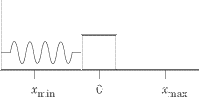
Suppose you push the mass toward the wall, compressing the spring,
until the mass is in position x = xmin .
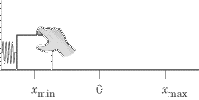
When you release the mass, the spring will exert a force, pushing the mass
back until it reaches position , which is called the amplitude of the spring’s motion,
or the maximum displacement of the oscillator. Note that . xmin = -xmax
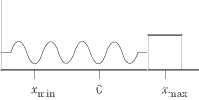
By that point, the spring will be stretched out, and will be exerting a
force to pull the mass back in toward the wall. Because we are dealing with an
idealized frictionless surface, the mass will not be slowed by the force of friction,
and will oscillate back and forth repeatedly between xmin and xmax.
Hooke’s Law
This is all well and good, but we can’t get very far in sorting out the
amplitude, the velocity, the energy, or anything else about the mass’s motion if
we don’t understand the manner in which the spring exerts a force on the mass
attached to it. The force, F,
that the spring exerts on the mass is defined by Hooke’s Law:
F = -kz
where x is the spring’s
displacement from its equilibrium position and
k is a constant of proportionality called the spring constant.
The spring constant is a measure of “springiness”: a greater value for
k signifies a “tighter” spring, one
that is more resistant to being stretched.
Hooke’s Law tells us that the further the spring is displaced from its
equilibrium position (x) the
greater the force the spring will exert in the direction of its equilibrium
position (F). We call
F a restoring force:
it is always directed toward equilibrium. Because F and x are directly
proportional, a graph of F vs. x
is a line with slope –k.
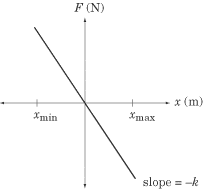
Simple Harmonic Oscillation
A mass oscillating on a spring is one example of a simple harmonic oscillator.
Specifically, a simple harmonic oscillator is any object that moves about a
stable equilibrium point and experiences a restoring force proportional to the
oscillator’s displacement.
For an oscillating spring, the restoring force, and consequently the
acceleration, are greatest and positive at
xmin.
These quantities decrease as x approaches the equilibrium position and
are zero at x =
0. The restoring force and
acceleration—which are now negative—increase in magnitude as
x approaches
xmax
and are maximally negative at
xmax.
Important Properties of a Mass on a Spring
There are a number of important properties related to the motion of a mass on a
spring, all of which are fair game for subject test Physics. Remember, though: the
test makers have no interest in testing your ability to recall complex formulas
and perform difficult mathematical operations. You may be called upon to know
the simpler of these formulas, but not the complex ones. As we mentioned at the
end of the section on pulleys, it’s less important that you memorize the
formulas and more important that you understand what they mean. If you
understand the principle, there probably won’t be any questions that will stump
you.
Period of Oscillation
The period of oscillation, T, of a
spring is the amount of time it takes for a spring to complete a round-trip or
cycle. Mathematically, the period of oscillation of a simple harmonic oscillator
described by Hooke’s Law is:

This equation tells us that as the mass of the block,
m, increases and the spring
constant, k, decreases, the period
increases. In other words, a heavy mass attached to an easily stretched spring
will oscillate back and forth very slowly, while a light mass attached to a
resistant spring will oscillate back and forth very quickly.
Frequency
The frequency of the spring’s motion tells us how quickly the object is
oscillating, or how many cycles it completes in a given timeframe. Frequency is
inversely proportional to period:
f = 1/T
Frequency is given in units of cycles per second, or hertz (Hz).
Potential Energy
The potential energy of a spring (Us)
is sometimes called elastic energy, because it results from the spring being
stretched or compressed. Mathematically,
Us
is defined by:
U = 1/2 kx2
The potential energy of a spring is greatest when the coil is maximally
compressed or stretched, and is zero at the equilibrium position.
Kinetic Energy
subject test Physics will not test you on the motion of springs involving friction, so
for the purposes of the test, the mechanical energy of a spring is a conserved
quantity. As we recall, mechanical energy is the sum of the kinetic energy and
potential energy.
At the points of maximum compression and extension, the velocity, and hence the
kinetic energy, is zero and the mechanical energy is equal to the potential
energy, Us=
1/21/2 kx2.
At the equilibrium position, the potential energy is zero, and the velocity and
kinetic energy are maximized. The kinetic energy at the equilibrium position is
equal to the mechanical energy:
KEmax = mv2 = 1/2 kx2max
From this equation, we can derive the maximum velocity:

You won’t need to know this equation, but it might be valuable to note that the
velocity increases with a large displacement, a resistant spring, and a small
mass.
Summary
It is highly unlikely that the formulas discussed above will appear on subject test
Physics. More likely, you will be asked conceptual questions such as: at what
point in a spring’s oscillation is the kinetic or potential energy maximized or
minimized, for instance. The figure below summarizes and clarifies some
qualitative aspects of simple harmonic oscillation. Your qualitative
understanding of the relationship between force, velocity, and kinetic and
potential energy in a spring system is far more likely to be tested than your
knowledge of the formulas discussed above.
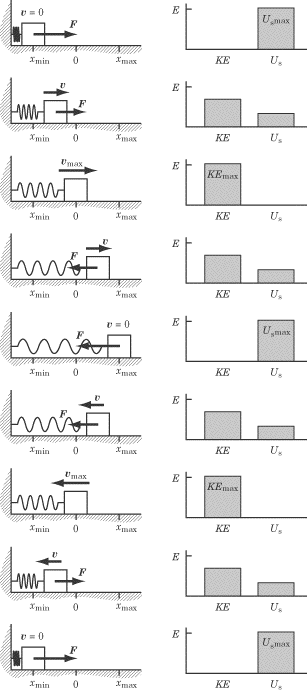
In this figure, v represents velocity, F represents force,
KE represents kinetic energy, Us and represents potential energy.
Vertical Oscillation of Springs
Now let’s consider a mass attached to a spring that is suspended from the
ceiling. Questions of this sort have a nasty habit of coming up on subject test
Physics. The oscillation of the spring when compressed or extended won’t be any
different, but we now have to take gravity into account.
Equilibrium Position
Because the mass will exert a gravitational force to stretch the spring downward
a bit, the equilibrium position will no longer be atx = 0, but at x =
–h, where h is the vertical displacement of the spring due to the
gravitational pull exerted on the mass. The equilibrium position is the point
where the net force acting on the mass is zero; in other words, the point where
the upward restoring force of the spring is equal to the downward gravitational
force of the mass.
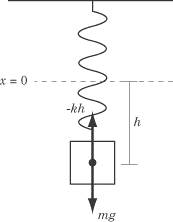
Combining the restoring force, F = –kh, and the gravitational force, F = mg, we can solve for h:
-kh = mg
-h = mg/k
Since m is in the numerator and k in the denominator of the
fraction, the mass displaces itself more if it has a large weight and is
suspended from a lax spring, as intuition suggests.
A Vertical Spring in Motion
If the spring is then stretched a distance d, where d < h,
it will oscillate between
Xmax = -b - d
and
Xmin = -b + d.
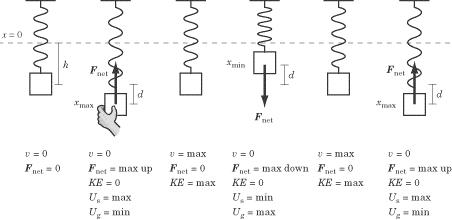
Throughout the motion of the mass, the force of gravity is constant and
downward. The restoring force of the spring is always upward, because even at
Xmin
the mass is below the spring’s initial equilibrium position of x = 0.
Note that if d were greater than h,
Xmin
would be above x = 0, and the restoring force would act in the downward
direction until the mass descended once more below x = 0.
According to Hooke’s Law, the restoring force decreases in magnitude as the
spring is compressed. Consequently, the net force downward is greatest at
X = Xmin
and the net force upward is greatest at
X = Xmax.
Energy
The mechanical energy of the vertically oscillating spring is:
KE = U9 + Us
where Ug is gravitational potential energy and Us is the spring’s (elastic)
potential energy.
Note that the velocity of the block is zero at
X = Xmin
and
X = Xmax ,
and maximized at the equilibrium position, x =
–h. Consequently, the kinetic energy of the spring is zero for
X = Xmax
and
X = Xmin
and is greatest at x = –h. The
gravitational potential energy of the system increases with the height of the
mass. The elastic potential energy of the spring is greatest when the spring is
maximally extended at
X = Xmax
and decreases with the extension of the spring.
How This Knowledge Will Be Tested
Most of the questions on subject test Physics that deal with spring motion will ask
qualitatively about the energy or velocity of a vertically oscillating spring.
For instance, you may be shown a diagram capturing one moment in a spring’s
trajectory and asked about the relative magnitudes of the gravitational and
elastic potential energies and kinetic energy. Or you may be asked at what point
in a spring’s trajectory the velocity is maximized. The answer, of course, is
that it is maximized at the equilibrium position. It is far less likely that you
will be asked a question that involves any sort of calculation.
Back
Next
Next to display next topic in the chapter.
Practice Questions
Video Lessons and 10 Fully Explained Grand Tests
Large number of solved practice MCQ with explanations. Video Lessons and 10 Fully explained Grand/Full Tests.